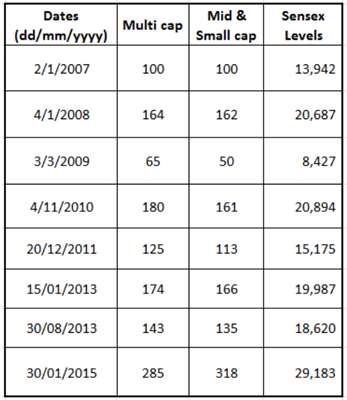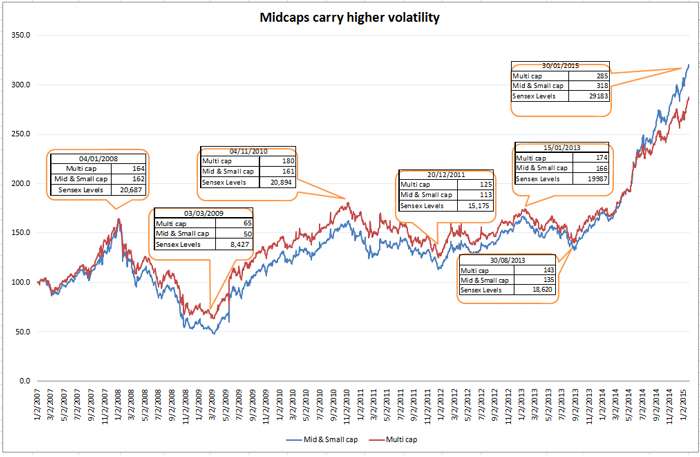We recently received a query from an investor who asked us – “Why should I invest for the long term (more than five years), when I receive more than 100 per cent returns in one year?” Over the last one year, six mid- and small- cap funds have generated triple-digit returns, and a number of mid- and small-cap funds have generated more than 75 per cent returns. Every mutual fund company highlights the following lines just below their performance numbers: ‘Past performance may or may not be sustained in future.’ However, many of you still believe that you will get the same returns as the previous year, and are disappointed when you don’t.
This is especially true of mid- and small-cap funds, where the high returns in rallies mask the risks that such funds otherwise carry.

In the above chart, you will see how Rs100 invested in multi-cap diversified funds and mid-cap funds respectively, has grown from 2007 till date. For this purpose, we took funds with over Rs 100 crore AUM (a threshold we consider for our research and recommendation purpose) and those funds that existed over this time frame. 28 multi-cap funds and 20 mid-cap funds came in this filter.
We define multi-cap funds as those with 50 per cent to 75 per cent average assets in large-cap stocks (large cap stocks with above Rs 10,000 crore market capitalisation) over the last three years. We define mid- and small-cap funds as those with more than 50 per cent to 75 per cent average assets in mid and small cap stocks (below Rs.10,000 crore market capitalisation).

*Value of Rs 100 invested equally in multi-cap funds and mid-cap funds.
The graph shows that mid- and small-cap funds swing more than multi-caps. Multi-cap funds, on the other hand, contain declines better and do not lose much on the upside in rallies. It is important to understand this volatility prevalent in mid-cap funds before you invest.
While exposure to mid-cap funds can pep your portfolio returns, they should ideally be invested in through the SIP
mode. The huge swings provide room for cost averaging to work and cushion downside risks better. A better alternative to pure mid-cap funds, if you cannot handle these swings, is to go for a diversified multi-cap fund, where the fund manager can increase or decrease exposure to mid- and small-cap stocks based on relative valuation and earnings expectation.
As diversified funds would have exposure to large-cap stocks as well, their volatility can be expected to be lower than pure mid-cap funds. The graph is evidence to the fact that diversified multi-cap funds contain downsides better and do not also lag much during rallying markets.
How much exposure to take: The amount of exposure you can take to funds in the mid- and small-cap category is dependent on your risk appetite and your understanding of this market cap segment. In general, we do not
recommend over 20-30 per cent of your equity exposure to pure mid- and small-cap funds. Remember, you are also
taking further exposure to the mid- and small-cap segment through diversified funds. Hence, your overall exposure will be higher.
How long to invest: As far as possible, invest in mid-cap funds through the SIP mode. The SIP by itself has to be either for the time period of your goal, or for a minimum of 3-5 years. When you do an asset allocation review annually, and you find that your equity allocation is way above your original allocation. So, prune your mid-cap funds first when you rebalance your assets.
The risks in this market-cap segment: You should be aware of the risks of companies that are present in the mid- and small-cap segment. Many small-cap companies are dependent on debt for their growth. That means they
may be highly leveraged. This could hurt them in a downturn, or when interest rates are high. Besides, there is the risk of lack of liquidity in this market-cap segment. That means there may not be very large quantities of shares floated in stock exchanges when it comes to small companies. A large transaction can impact the stocks’ prices. This is something fund managers are constantly conscious of when they buy or sell stocks in this market-cap segment.
In a falling market, when Foreign Institutional Investors (FIIs) or other categories of investors dump some of these stocks, the price can take a hard knock. Another risk with this category of funds is that the fund manager is mandated to hold at least 50-70 per cent in stocks in the said market-cap segment. That means they cannot move to larger market caps even when the market movements require them to.
To sum up:
• In all, when you go for funds in the mid- and small-cap category, look for stability in performance and do not be carried away by one-year returns.
• Place a cap on pure mid-cap funds in your portfolio.
• Invest through the SIP mode to combat volatility in these funds.
• When you do an annual asset rebalancing, make sure you book profits in mid-cap funds and redeploy in the under-owned asset class in your portfolio.








Can you name the multi cap funds for it is not mentioned in your select funds list. Thanks
Hi Michael
Few funds are highlighted below, Axis Equity Fund,Birla Sun Life Top 100 Fund, BNP Paribas Equity Fund,ICICI Prudential Dynamic Plan,Kotak Select focus,Mirae Asset India Opportunities Fund, Reliance Equity Opportunities Fund and UTI Equity
Thanks
Sathyamoorthy
Can you name the multi cap funds for it is not mentioned in your select funds list. Thanks
Hi Michael
Few funds are highlighted below, Axis Equity Fund,Birla Sun Life Top 100 Fund, BNP Paribas Equity Fund,ICICI Prudential Dynamic Plan,Kotak Select focus,Mirae Asset India Opportunities Fund, Reliance Equity Opportunities Fund and UTI Equity
Thanks
Sathyamoorthy